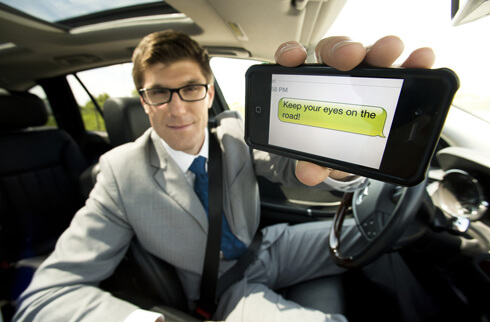
May 29, 2013
Recently released results from a new Virginia Tech Transportation Institute (VTTI) naturalistic driving study continue to show that distracted driving is a tangible threat.
The study, entitled The Impact of Hand-Held and Hands-Free Cell Phone Use on Driving Performance and Safety Critical Event Risk, shows that engaging in visual-manual subtasks (such as reaching for a phone, dialing and texting) associated with the use of hand-held phones and other portable devices increased the risk of getting into a crash by three times. The data were collected by VTTI and Westat. The study, which was conducted under a separate contract from the National Highway Traffic Safety Administration (NHTSA), found:
- Text messaging, browsing and dialing resulted in the longest duration of drivers taking their eyes off the road.
- Text messaging increased the risk of a crash or near-crash by two times and resulted in drivers taking their eyes off the road for an average of 23 seconds total.
- Activities performed when completing a phone call (reaching for a phone, looking up a contact and dialing the number) increased crash risk by three times.
- There is no direct increased crash risk from the specific act of talking on a cell phone. However, visual-manual tasks (locating the phone, looking at the phone and touching the phone) are always involved when using a hand-held cell phone. This makes the overall use of a hand-held cell phone riskier when driving.
- Even portable hands-free and vehicle-integrated hands-free cell phone use involved visual-manual tasks at least half of the time, which is associated with a greater crash risk.
Additional details of safety-critical event risks related to cell phone use are included in the following table. To learn more about the VTTI study, view the full report here.
Safety-critical Event Risk Associated with Cell Phone Use
| Subtask | Rate Ratio | 95% Confidence Interval* |
|---|---|---|
| Overall Cell Phone Use | 1.32 | 0.96 – 1.81 |
| Visual-manual Subtask (such as looking at or touching a cell phone, reaching for the phone, dialing, texting, etc.) | 2.93** | 1.90 – 4.51 |
|
Call-related Visual-manual Subtask |
3.34** | 1.76 – 6.35 |
|
Text-related Visual-manual Subtask |
2.12** | 1.14 – 3.96 |
|
Talking/Listening |
0.84 | 0.55 – 1.29 |
|
Talking/Listening (Hand-held Phone) |
0.84 | 0.47 – 1.53 |
|
Talking/Listening (Portable Hands-free, such as a Bluetooth earpiece) |
1.19 | 0.55 – 2.57 |
|
Talking/Listening (Integrated Hands-free, which is built into the vehicle navigation system) |
0.61 | 0.27 – 1.41 |
| Hand-held Cell Phone Use | 1.73** | 1.20 – 2.49 |
| Portable Hands-free Cell Phone Use | 1.06 | 0.49 – 2.30 |
| Integrated Hands-free Cell Phone Use | 0.57 | 0.25 – 1.31 |
* Indicates 95% confidence that the actual safety-critical event risk falls within the lower and upper limits
** Indicates a difference at the .05 level of significance
Source: Fitch, G. A., Soccolich, S. A., Guo, F., McClafferty, J., Fang, Y., Olson, R. L., Perez, M. A., Hanowski, R. J., Hankey, J. M., & Dingus, T. A. (2013, April). The impact of hand-held and hands-free cell phone use on driving performance and safety-critical event risk. (Report No. DOT HS 811 757). Washington, DC: National Highway Traffic Safety Administration